From Map to Policy: Road Transportation Emission Mapping and Optimizing BEV Incentives for True Emission Reductions
Abstract
1. Introduction
1.1. Contributions
- Quantification of the spatial differences in automotive emissionsIntegration of open-source data on regional vehicle stock, consumption values, and average mileage data to assess spatial emission variations.
- Comprehensive analysis regarding TtW and WtW perspectivesAssessment of the emissions gap for the German fleet stock by considering various calculation methods.
- Novel investigation on the leverage of spatially driven electromobility subsidesQuantifying the leverage of spatially driven subsidies, aiming to maximize emission reduction.
1.2. Organization of the Article
2. Materials and Methods
2.1. Vehicle Data
2.2. Mobility Data
2.3. Geographical Data
2.4. Emission Calculation
| Petrol | Diesel | Electricity | Source | |
|---|---|---|---|---|
| in CO2-eq./l | ||||
| TtW | 2.60 | 2.95 | - | [44,45] |
| WtT | 0.14 | 0.13 | - | [46,47] |
| WtW | 2.73 | 3.08 | - | [48] |
| in CO2-eq./kWh | ||||
| TtW | 0.297 | 0.296 | 0 | [44,45] |
| WtT | 0.016 | 0.013 | 0.552 | [46,47,49] |
| WtW | 0.312 | 0.309 | 0.552 | [48] |
2.5. Allocation Algorithm
3. Results
3.1. Heterogeneity of Consumption, Mileage, and Emissions
3.2. TtW vs. WtW Perspectives
3.3. Spatially Informed BEV Distribution
4. Discussion
5. Conclusions
- Underlying data needed to calculate road-based emissions of passenger cars differ significantly across regions. Evaluated for counties in Germany, spreads of and for consumption and annual mileage values data were calculated.
- The choice of perspective has a significant influence on the absolute values. Moreover, the composition of the fleet and respected electricity mix further deviates TtW and WtW values, their gap, and the spread of values.
- Spatially informed calculations and the regionally optimized allocation of BEVs to the fleet can reduce GHG emissions more efficiently than current approaches. Using this approach allows for improved policies incentivizing green transportation, such as subsidies for BEVs, leading to a more efficient use of governmental resources.
Author Contributions
Funding
Institutional Review Board Statement
Informed Consent Statement
Data Availability Statement
Acknowledgments
Conflicts of Interest
Abbreviations
| ADAC | General German Automobile Club |
| BBSR | Federal Institute for Research on Building |
| BEV | battery electric vehicle |
| BIK | life cycle assessment |
| EU | European Union |
| GHG | greenhouse gas |
| ICE | internal combustion engine |
| KBA | Federal Motor Transport Authority |
| KSG | Klimaschutzgesetz |
| LCA | life cycle assessment |
| MiD | Mobility in Germany |
| MIV | motorized individual vehicle |
| NUTS | Nomenclature of Territorial Units for Statistics |
| PHEV | plug-in hybrid electric vehicle |
| RegioStar | regional statistical spatial typology |
| TtW | tank-to-wheel |
| UBA | Umweltbundesamt |
| UK | United Kingdom |
| US | United States |
| WtT | well-to-tank |
| WtW | well-to-wheel |
References
- Olhoff, A.; Bataille, C.; Christensen, J.; den Elzen, M.; Fransen, T.; Grant, N.; Blok, K.; Kejun, J.; Soubeyran, E.; Lamb, W.; et al. Emissions Gap Report 2024: No More Hot Air … Please! With a Massive Gap Between Rhetoric and Reality, Countries Draft New Climate Commitments; United Nations Environment Programme: Nairobi, Kenya, 2024. [Google Scholar] [CrossRef]
- Eurostat. Greenhouse Gas Emissions by Source Sector: Product Code: env_air_gge; European Environment Agency (EEA): Copenhagen, Denmark, 2022. [Google Scholar] [CrossRef]
- Anteil des Verkehrs an den Treibhausgas-Anteil des Verkehrs an den Treibhausgas-Emissionen in Deutschland. Available online: https://www.umweltbundesamt.de/daten/verkehr/emissionen-des-verkehrs#verkehr-belastet-luft-und-klima-minderungsziele-der-bundesregierung (accessed on 4 December 2024).
- Kuhnimhof, T.; Wirtz, M.; Manz, W. Decomposing Young Germans’ Altered Car Use Patterns. Transp. Res. Rec. J. Transp. Res. Board 2012, 2320, 64–71. [Google Scholar] [CrossRef]
- Eisenmann, C.; Nobis, C.; Kolarova, V.; Lenz, B.; Winkler, C. Transport mode use during the COVID-19 lockdown period in Germany: The car became more important, public transport lost ground. Transp. Policy 2021, 103, 60–67. [Google Scholar] [CrossRef]
- United Nations Framework Convention on Climate Change (UNFCCC). Paris Agreement. Adopted at the 21st Conference of the Parties (COP21), Paris, France. Available online: https://unfccc.int/process-and-meetings/the-paris-agreement/the-paris-agreement (accessed on 11 March 2025).
- Klimaschutzplan 2050: Klimaschutzpolitische Grundsätze und Ziele der Bundesregierung. Available online: https://www.bmwk.de/Redaktion/DE/Publikationen/Industrie/klimaschutzplan-2050.pdf?__blob=publicationFile&v=1 (accessed on 11 March 2025).
- Klimaschutzprogramm 2030 der Bundesregierung zur Umsetzung des Klimaschutzplans 2050. Available online: https://www.bundesregierung.de/resource/blob/974430/1679914/e01d6bd855f09bf05cf7498e06d0a3ff/2019-10-09-klima-massnahmen-data.pdf?download=1 (accessed on 11 March 2025).
- Bundestag. Bundes-Klimaschutzgesetz vom 12. Dezember 2019 (BGBl. I S. 2513), das Durch Artikel 1 des Gesetzes vom 18. August 2021 (BGBl. I S. 3905) geändert Worden Ist: KSG. Available online: https://www.gesetze-im-internet.de/ksg/KSG.pdf (accessed on 26 February 2024).
- Bundestag. Erstes Gesetz zur Änderung des Bundes-Klimaschutzgesetzes. Available online: https://www.bgbl.de/xaver/bgbl/start.xav?startbk=Bundesanzeiger_BGBl&start=//*%5b@attr_id=%27bgbl121s3905.pdf%27%5d#__bgbl__%2F%2F*%5B%40attr_id%3D%27bgbl121s3905.pdf%27%5D__1708944546162 (accessed on 26 February 2024).
- Bundestag. Zweites Gesetz zur Änderung des Bundes-Klimaschutzgesetzes. Available online: https://www.recht.bund.de/bgbl/1/2024/235/regelungstext.pdf?__blob=publicationFile&v=2 (accessed on 11 March 2025).
- Projektionsbericht 2023 für Deutschland. Available online: https://www.umweltbundesamt.de/sites/default/files/medien/11850/publikationen/39_2023_cc_projektionsbericht_12_23.pdf (accessed on 8 February 2024).
- Overview of EPA’s MOtor Vehicle Emission Simulator (MOVES5). Available online: https://www.epa.gov/system/files/documents/2024-11/420r24011.pdf (accessed on 5 December 2024).
- Ntziachristos, L.; Gzatzoflias, D.; Kouridis, C.; Samaras, Z. COPERT: A European Road Transport Emission Inventory Model. In Environmental Science and Engineering; Springer: Berlin/Heidelberg, Germany, 2009; pp. 491–504. [Google Scholar] [CrossRef]
- Allekotte, M.; Biemann, K.; Heidt, C.; Colson, M.; Knörr, W. Aktualisierung der Modelle TREMOD/TREMOD-MM für die Emissionsberichterstattung 2020 (Berichtsperiode 1990–2018): Berichtsteil “TREMOD”. Available online: https://www.umweltbundesamt.de/sites/default/files/medien/1410/publikationen/2020-06-29_texte_116-2020_tremod_2019_0.pdf (accessed on 16 February 2024).
- Bergk, F.; Heidt, C.; Knörr, W.; Keller, M. Erweiterung der Software TREMOD um Zukünftige Fahrzeugkonzepte, Antriebe und Kraftstoffe; Vol. Heft 113, Berichte der Bundesanstalt für Straßenwesen; Fachverlag NW in der Carl Schünemann Verlag GmbH: Bremen, Germany, 2016. [Google Scholar]
- Schmidt, M.; Höpfner, U. 20 Jahre ifeu-Institut; Vieweg+Teubner Verlag: Wiesbaden, Germany, 1998. [Google Scholar] [CrossRef]
- Allekotte, M.; Heidt, C.; Knörr, W.; Kotzagiorgis, S.; Schneider, W. Modellintegration des TransportVisualisierungsmodells (TraViMo) und dem Transport Emission Model (TREMOD). Available online: https://digital.bibliothek.uni-halle.de/pe/download/pdf/3252971?originalFilename=true (accessed on 11 March 2025).
- Di, W.; Guo, F.; Field, F.R.; de Kleine, R.D.; Kim, H.C.; Wallington, T.J.; Kirchain, R.E. Regional Heterogeneity in the Emissions Benefits of Electrified and Lightweighted Light-Duty Vehicles. Environ. Sci. Technol. 2019, 53, 10560–10570. [Google Scholar] [CrossRef]
- Yuksel, T.; Michalek, J.J. Effects of regional temperature on electric vehicle efficiency, range, and emissions in the United States. Environ. Sci. Technol. 2015, 49, 3974–3980. [Google Scholar] [CrossRef]
- Yuksel, T.; Tamayao, M.A.M.; Hendrickson, C.; Azevedo, I.M.L.; Michalek, J.J. Effect of regional grid mix, driving patterns and climate on the comparative carbon footprint of gasoline and plug-in electric vehicles in the United States. Environ. Res. Lett. 2016, 11, 044007. [Google Scholar] [CrossRef]
- Tamayao, M.A.M.; Michalek, J.J.; Hendrickson, C.; Azevedo, I.M.L. Regional Variability and Uncertainty of Electric Vehicle Life Cycle CO2 Emissions across the United States. Environ. Sci. Technol. 2015, 49, 8844–8855. [Google Scholar] [CrossRef]
- Burnham, A.; Lu, Z.; Wang, M.; Elgowainy, A. Regional Emissions Analysis of Light-Duty Battery Electric Vehicles. Atmosphere 2021, 12, 1482. [Google Scholar] [CrossRef]
- Sacchi, R.; Bauer, C.; Cox, B.; Mutel, C. When, where and how can the electrification of passenger cars reduce greenhouse gas emissions? Renew. Sustain. Energy Rev. 2022, 162, 112475. [Google Scholar] [CrossRef]
- Kalinowska, D.; Kuhfeld, H. Motor Vehicle Use and Travel Behaviour in Germany: Determinants of Car Mileage. Available online: https://www.econstor.eu/bitstream/10419/18495/1/dp602.pdf (accessed on 3 December 2024).
- Niroomand, N.; Bach, C. Estimating Average Vehicle Mileage for Various Vehicle Classes Using Polynomial Models in Deep Classifiers. IEEE Access 2024, 12, 17404–17418. [Google Scholar] [CrossRef]
- Speth, D.; Gnann, T.; Plötz, P.; Wietschel, M.; George, J. Future regional distribution of electric vehicles in Germany. In Proceedings of the Electric Vehicle Symposium (EVS33), Portland, OR, USA, 14–17 June 2020; Volume 2020. [Google Scholar] [CrossRef]
- Ma, H.; Riera-Palou, X.; Harrison, A. Development of a new tank-to-wheels methodology for energy use and green house gas emissions analysis based on vehicle fleet modeling. Int. J. Life Cycle Assess. 2011, 16, 285–296. [Google Scholar] [CrossRef]
- Thiel, C.; Schmidt, J.; van Zyl, A.; Schmid, E. Cost and well-to-wheel implications of the vehicle fleet CO2 emission regulation in the European Union. Transp. Res. Part A Policy Pract. 2014, 63, 25–42. [Google Scholar] [CrossRef]
- Eggs, J.; Follmer, R.; Gruschwitz, D.; Nobis, C.; Bäumer, M.; Pfeiffer, M. Mobilität in Deutschland—MiD Methodenbericht. BMVI, infas, DLR, IVT, infas 360. Bonn, Berlin. Available online: https://www.mobilitaet-in-deutschland.de/archive/pdf/MiD2017_Methodenbericht.pdf (accessed on 22 December 2023).
- Vallée, J.; Ecke, L.; Chlond, B.; Vortisch, P. Deutsches Mobilitätspanel (MOP)—Wissenschaftliche Begleitung und Auswertungen Bericht 2021/2022: Alltagsmobilität und Fahrleistung; Karlsruher Institut für Technologie (KIT): Karlsruhe, Germany, 2022. [Google Scholar] [CrossRef]
- BVU Beratergruppe.; Intraplan Consult GmbH.; IVV GmbH & Co. KG.; Planco Consulting GmbH. Verkehrsverflechtungsprognose 2030: Schlussbericht. Available online: https://bmdv.bund.de/SharedDocs/DE/Anlage/G/verkehrsverflechtungsprognose-2030-schlussbericht-los-3.pdf?__blob=publicationFile (accessed on 14 January 2025).
- Adolf, J.; Balzer, C.; Joedicke, A.; Schabla, U.; Wilbrand, K.; Rommerskirchen, S.; Anders, N.; der Maur, A.A.; Straßburg, S.; Ehrentraut, O.; et al. Shell PKW-Szenarien bis 2040—Fakten, Trends und Perspektiven für Auto-Mobilität. Available online: https://www.prognos.com/sites/default/files/2021-01/140900_prognos_shell_studie_pkw-szenarien2040.pdf (accessed on 11 March 2025).
- Creutzig, F.; McGlynn, E.; Minx, J.; Edenhofer, O. Climate policies for road transport revisited (I): Evaluation of the current framework. Energy Policy 2011, 39, 2396–2406. [Google Scholar] [CrossRef]
- Poltimäe, H.; Rehema, M.; Raun, J.; Poom, A. In search of sustainable and inclusive mobility solutions for rural areas. Eur. Transp. Res. Rev. 2022, 14, 13. [Google Scholar] [CrossRef]
- Schulthoff, M.; Kaltschmitt, M.; Balzer, C.; Wilbrand, K.; Pomrehn, M. European road transport policy assessment: A case study for Germany. Environ. Sci. Eur. 2022, 34, 92. [Google Scholar] [CrossRef]
- Brückmann, G.; Bernauer, T. What drives public support for policies to enhance electric vehicle adoption? Environ. Res. Lett. 2020, 15, 094002. [Google Scholar] [CrossRef]
- Axsen, J.; Plötz, P.; Wolinetz, M. Crafting strong, integrated policy mixes for deep CO2 mitigation in road transport. Nat. Clim. Change 2020, 10, 809–818. [Google Scholar] [CrossRef]
- ADAC. Automarken & Modelle. Available online: https://www.adac.de/rund-ums-fahrzeug/autokatalog/marken-modelle/ (accessed on 30 January 2025).
- KBA. Personenkraftwagen im Durchschnitt 9,3 Jahre Alt. Available online: https://www.kba.de/DE/Statistik/Fahrzeuge/Bestand/Fahrzeugalter/2017/2017_b_fahrzeugalter_kurzbericht.html?nn=3524968&fromStatistic=3524968&yearFilter=2017&fromStatistic=3524968&yearFilter=2017 (accessed on 14 November 2024).
- Bäumer, M.; Hautzinger, H.; Pfeiffer, M. Mobilität in Deutschland 2017: Regionalisierung von MiD-Ergebnissen: Small-Area-Methoden zur Schätzung von Verkehrskennzahlen in Kleinräumiger Gliederung. Available online: https://www.mobilitaet-in-deutschland.de/archive/pdf/MiD2017_Bericht_Regionalisierung_MiD-Ergebnisse_Small_Area-Verfahren_1218.pdf (accessed on 14 November 2024).
- Geoportal of the European Commission. Communes, 2016—Administrative Units—Data Set. Available online: https://ec.europa.eu/eurostat/web/gisco/geodata/administrative-units/communes (accessed on 5 October 2024).
- Buberger, J.; Kersten, A.; Kuder, M.; Eckerle, R.; Weys, T.; Thiringer, T. Total CO2-equivalent life-cycle emissions from commercially available passenger cars. Renew. Sustain. Energy Rev. 2022, 159, 112158. [Google Scholar] [CrossRef]
- Gode, J.; Martinsson, F.; Hagberg, L.; Öman, A.; Höglund, J.; Palm, D. Miljöfaktaboken 2011: Uppskattade Emissionsfaktorer för bränslen, el, värme och Transporter. Available online: https://www.osti.gov/etdeweb/servlets/purl/1017957 (accessed on 11 March 2025).
- Notter, B.; Hausberger, S.; Matzer, C.; Weller, K.; Dippold, M.; Politschnig, N.; Lipp, S.; Allekotte, M.; Knörr, W.; André, M.; et al. HBEFA 4.2 Documentation of Updates. Available online: https://assets-global.website-files.com/6207922a2acc01004530a67e/6217584903e9f9b63093c8c0_HBEFA42_Update_Documentation.pdf (accessed on 16 February 2024).
- Benzin-mix-DE-2020 (inkl. Biokraftstoffe)—Basis (de): PROBAS Datensatz. Available online: https://data.probas.umweltbundesamt.de/datasetdetail/process.xhtml?uuid=2bf95e3a-317a-4642-aeb5-5d7089b6cf35&version=02.44.152&stock=PUBLIC&lang=de (accessed on 5 November 2024).
- Diesel-Mix-DE-2020 (inkl. Biokraftstoffe)—Basis (de): PROBAS Datensatz. Available online: https://data.probas.umweltbundesamt.de/datasetdetail/process.xhtml?uuid=e6893d83-cc42-46d3-a3d6-ddeb8a25fd0c&version=02.44.152&stock=PUBLIC&lang=de (accessed on 5 November 2024).
- Wietschel, M.; Moll, C.; Oberle, S.; Lux, B.; Timmerberg, S.; Neuling, U.; Kaltschmitt, M.; Ashley-Belbin, N. Klimabilanz, Kosten und Potenziale Verschiedener Kraftstoffarten und Antriebssysteme für Pkw und Lkw: Endbericht; Fraunhofer ISI: Karlsruhe, Germany, 2019. [Google Scholar] [CrossRef]
- Icha, P.; Lauf, T. Entwicklung der spezifischen Treibhausgas–Emissionen des deutschen Strommix in den Jahren 1990–2023. Available online: https://www.umweltbundesamt.de/sites/default/files/medien/11850/publikationen/23_2024_cc_strommix_11_2024.pdf (accessed on 5 November 2024).
- Alle Politisch Selbständigen Gemeinden mit Ausgewählten Merkmalen am 31.12.2017, im November 2018 Wegen Korrigierter Bevölkerung revidiert: Erscheinungsmonat: Oktober 2018, im November 2018 Revidiert Wegen Korrigierter Bevölkerung in Schleswig-Holstein und Baden-Württemberg. Available online: https://www.destatis.de/DE/Themen/Laender-Regionen/Regionales/Gemeindeverzeichnis/Administrativ/Archiv/GVAuszugJ/31122017_Auszug_GV.html (accessed on 11 March 2025).
- Treibhausgas-Projektionen für Deutschland: Technischer Anhang der Treibhausgas-Projektionen 2024 für Deutschland (Projektionsbericht 2024). Available online: https://www.umweltbundesamt.de/sites/default/files/medien/11850/publikationen/projektionen_technischer_anhang_0.pdf (accessed on 6 March 2025).
- Plötz, P.; Moll, C.; Bieker, G.; Mock, P.; Li, Y. Real-World Usage of Plug-In Hybrid Electric Vehicles: Fuel Consumption, Electric Driving, and CO2 Emissions; International Council on Clean Transportation Europe: Berlin, Germany, 2020. [Google Scholar]
- Andreassen, G.L.; Halse, A.H. Company cars and household car choices. Transp. Res. Part D Transp. Environ. 2024, 135, 104384. [Google Scholar] [CrossRef]
- Habla, W.; Huwe, V.; Kesternich, M. Electric and conventional vehicle usage in private and car sharing fleets in Germany. Transp. Res. Part D Transp. Environ. 2021, 93, 102729. [Google Scholar] [CrossRef]
- Schneider, J.; Wolff, S.; Seidenfus, M.; Lienkamp, M. Sizing up sustainability: Influence of battery size and cell chemistry on battery-electric trucks’ life-cycle carbon emissions. e-Prime Adv. Electr. Eng. Electron. Energy 2024, 9, 100656. [Google Scholar] [CrossRef]
- Wolff, S.; Seidenfus, M.; Brönner, M.; Lienkamp, M. Multi-disciplinary design optimization of life cycle eco-efficiency for heavy-duty vehicles using a genetic algorithm. J. Clean. Prod. 2021, 318, 128505. [Google Scholar] [CrossRef]
- Verkehr in Kilometern (VZ): Zeitreihe 2014–2023. Available online: https://www.kba.de/DE/Statistik/Kraftverkehr/VerkehrKilometer/vk_inlaenderfahrleistung/vk_inlaenderfahrleistung_node.html (accessed on 20 January 2025).

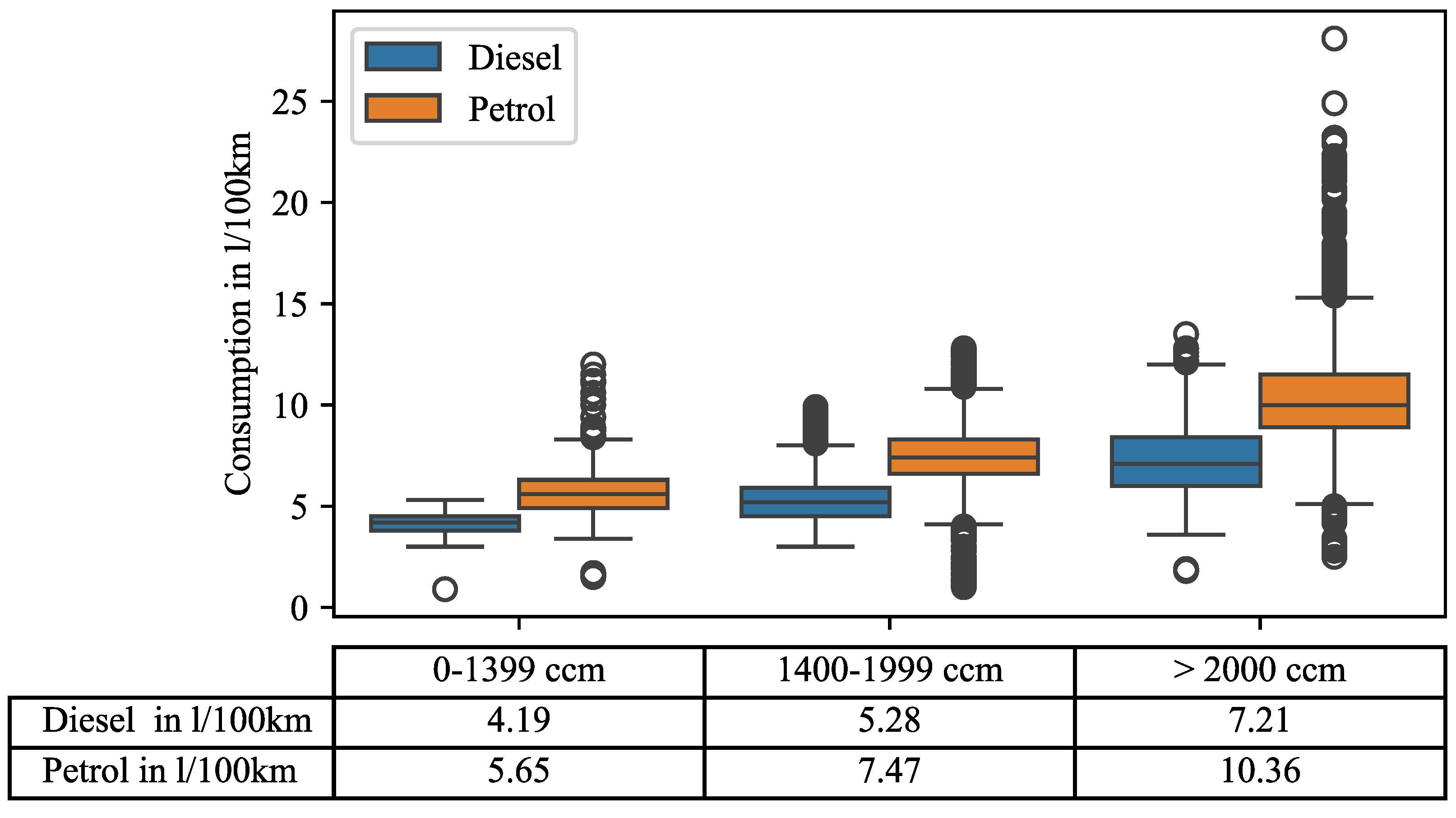


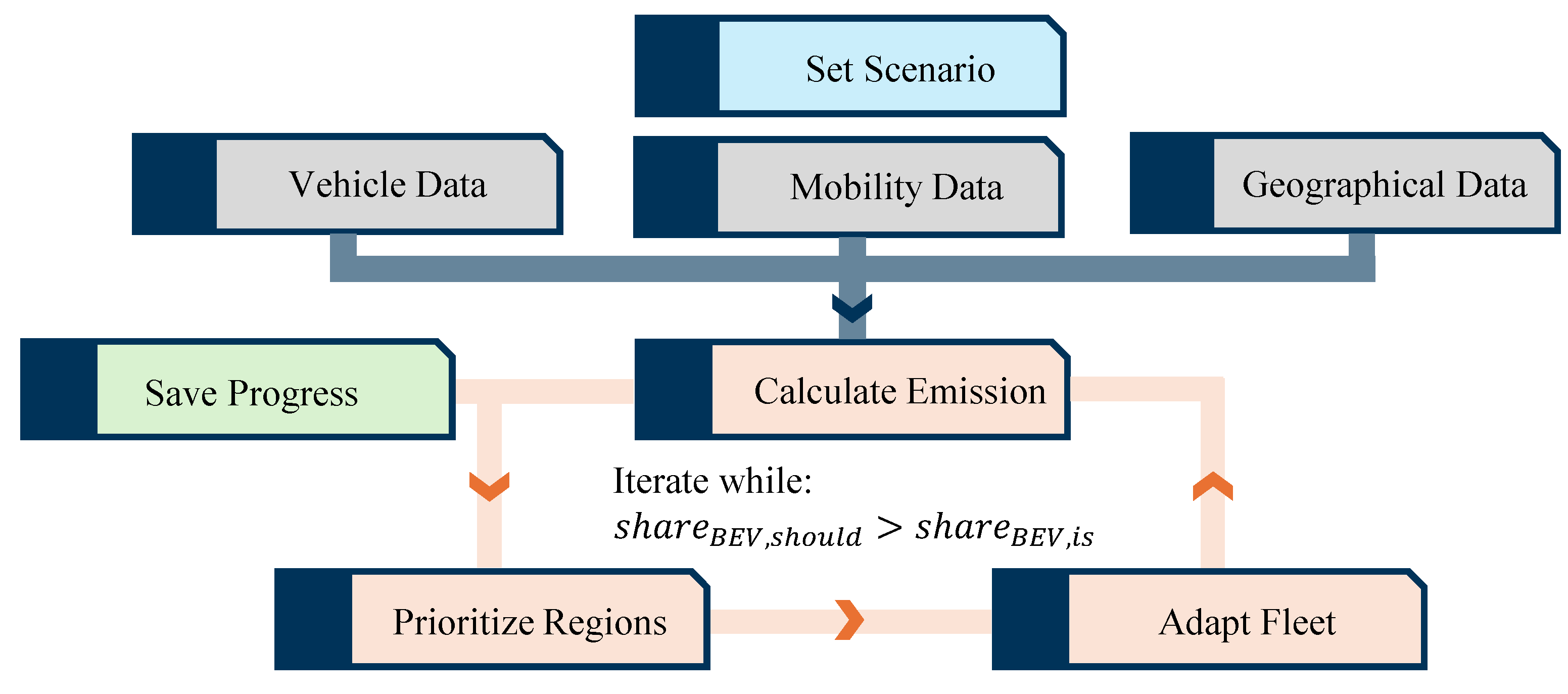
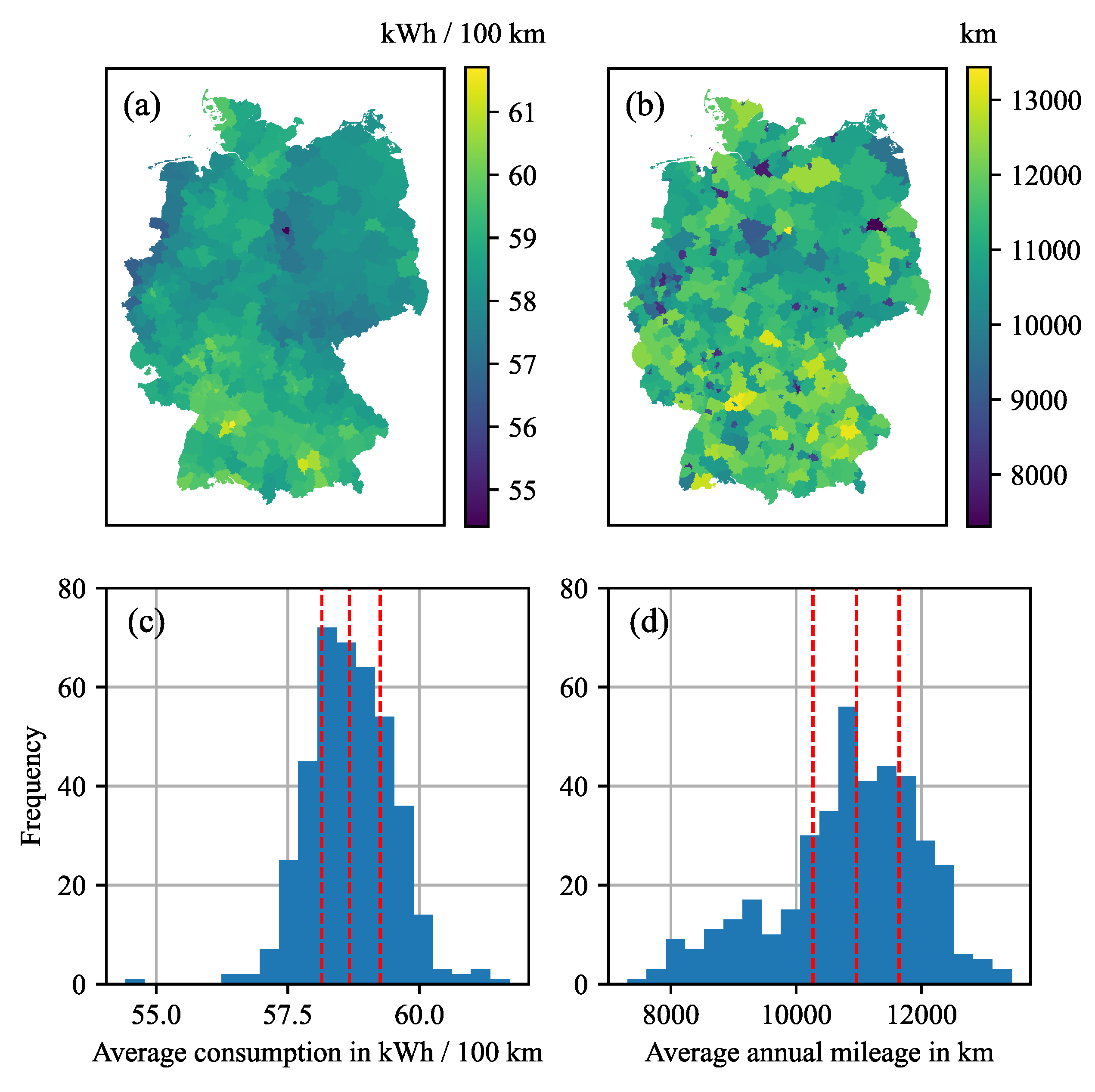
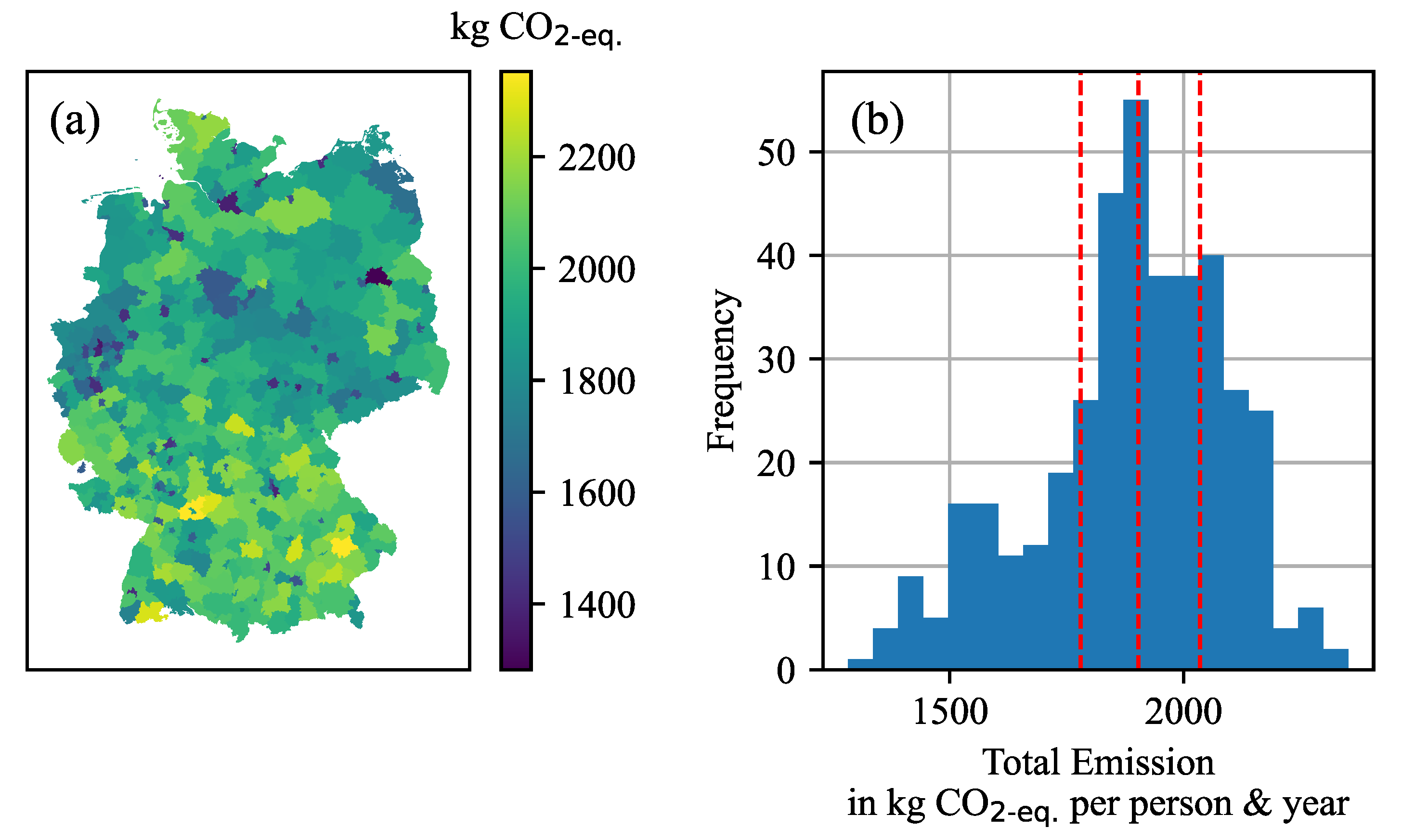

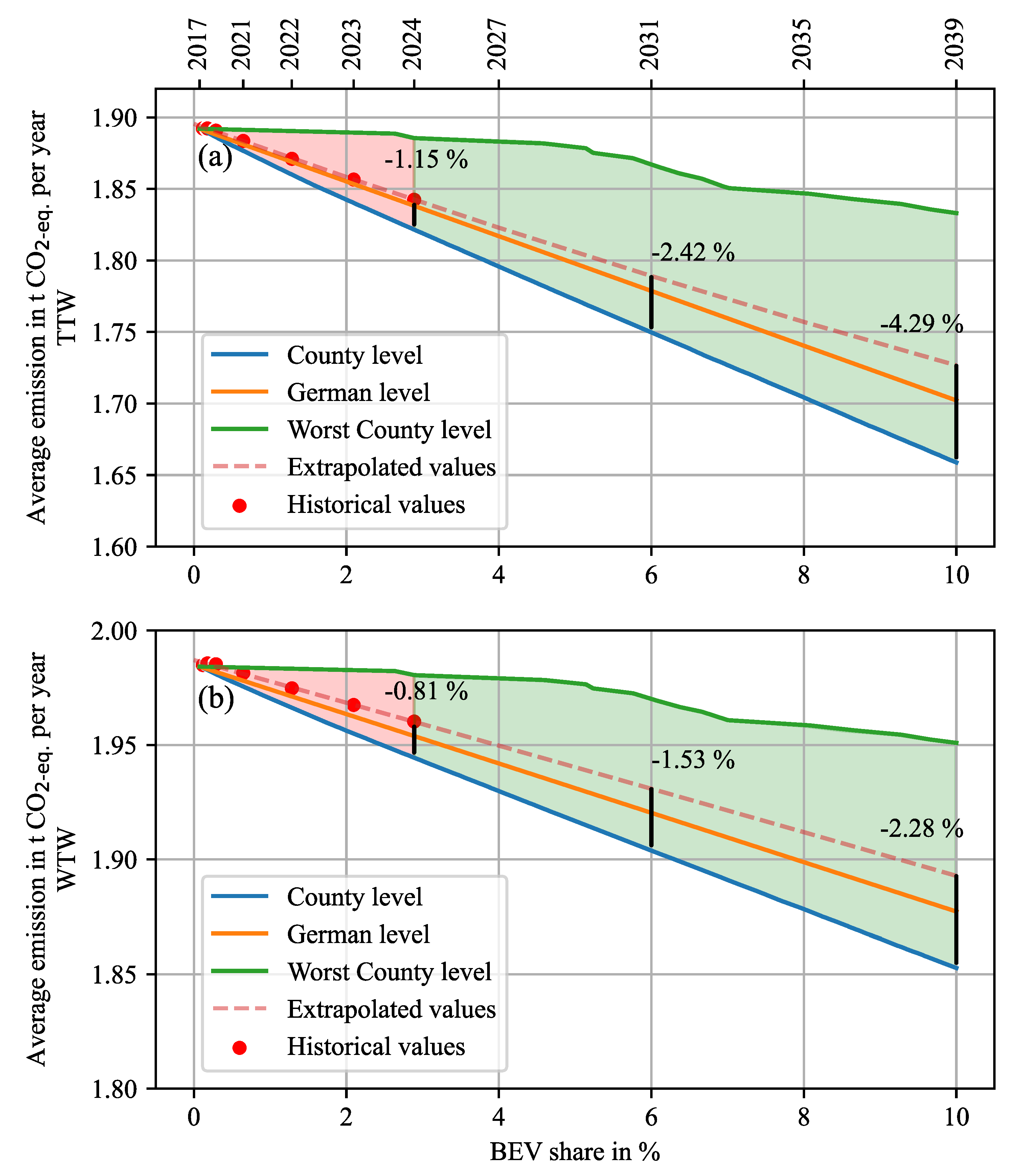
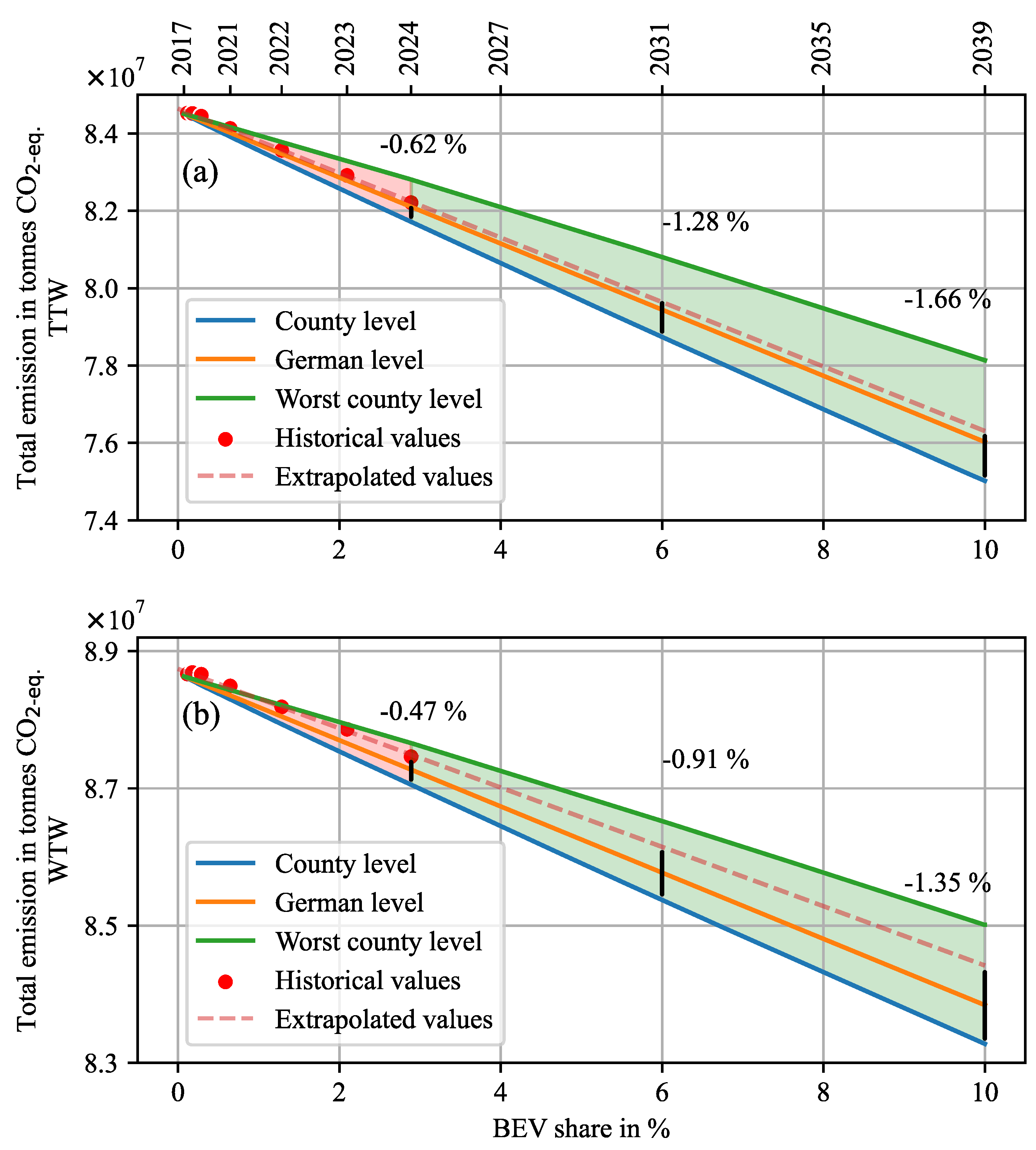
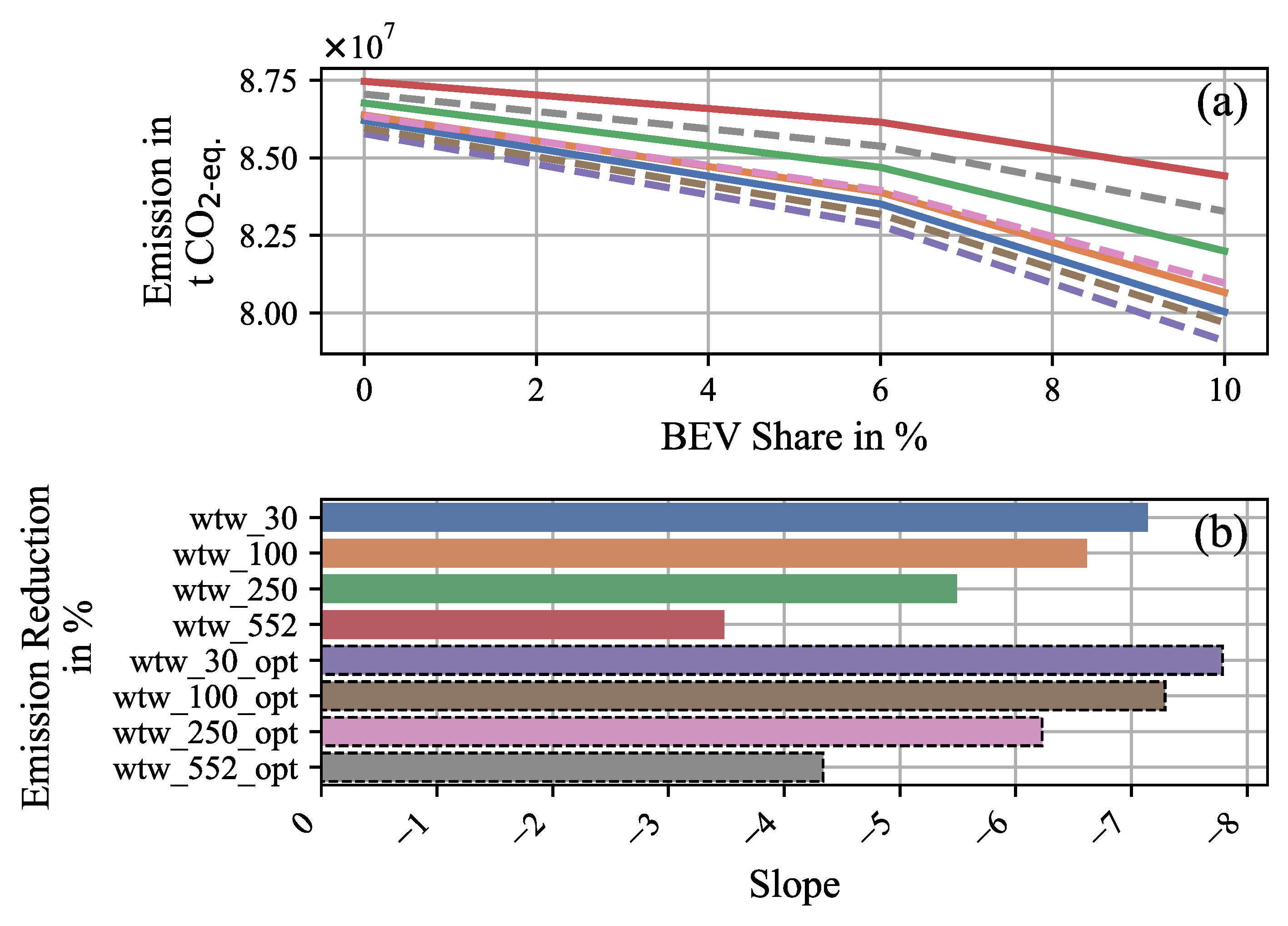
Disclaimer/Publisher’s Note: The statements, opinions and data contained in all publications are solely those of the individual author(s) and contributor(s) and not of MDPI and/or the editor(s). MDPI and/or the editor(s) disclaim responsibility for any injury to people or property resulting from any ideas, methods, instructions or products referred to in the content. |
© 2025 by the authors. Published by MDPI on behalf of the World Electric Vehicle Association. Licensee MDPI, Basel, Switzerland. This article is an open access article distributed under the terms and conditions of the Creative Commons Attribution (CC BY) license (https://creativecommons.org/licenses/by/4.0/).
Share and Cite
Seidenfus, M.; Schneider, J.; Lienkamp, M. From Map to Policy: Road Transportation Emission Mapping and Optimizing BEV Incentives for True Emission Reductions. World Electr. Veh. J. 2025, 16, 205. https://doi.org/10.3390/wevj16040205
Seidenfus M, Schneider J, Lienkamp M. From Map to Policy: Road Transportation Emission Mapping and Optimizing BEV Incentives for True Emission Reductions. World Electric Vehicle Journal. 2025; 16(4):205. https://doi.org/10.3390/wevj16040205
Chicago/Turabian StyleSeidenfus, Moritz, Jakob Schneider, and Markus Lienkamp. 2025. "From Map to Policy: Road Transportation Emission Mapping and Optimizing BEV Incentives for True Emission Reductions" World Electric Vehicle Journal 16, no. 4: 205. https://doi.org/10.3390/wevj16040205
APA StyleSeidenfus, M., Schneider, J., & Lienkamp, M. (2025). From Map to Policy: Road Transportation Emission Mapping and Optimizing BEV Incentives for True Emission Reductions. World Electric Vehicle Journal, 16(4), 205. https://doi.org/10.3390/wevj16040205






